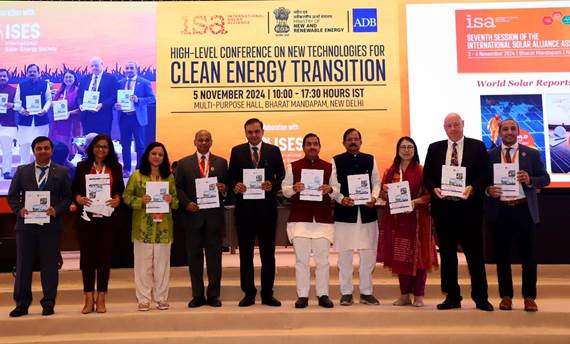
New Delhi: In just two decades, global solar capacity has exploded from 1.22 GW in 2000 to an astounding 1,418.97 GW in 2023—a staggering 40% annual growth rate, the 3rd edition of the World Solar Market Report released at the 7th Assembly of the International Solar Alliance (ISA) revealed. The report projects that global solar capacity is set to skyrocket to between 5457 and 7203 GW by 2030, driven by Paris Agreement commitments. This surge underscores the massive infrastructure push needed to meet climate goals.
In 2023 alone, 345.83 GW of solar power was added, accounting for three-quarters of all new renewable capacity worldwide. Solar generation has surged similarly, rocketing from 1.03 TWh in 2000 to 1,628.27 TWh in 2023.
The clean energy industry now fuels 16.2 million jobs, with solar leading the charge at 7.1 million—up 44% from 2022’s 4.9 million. And a striking 86% of these jobs are concentrated in just 10 countries.
By the close of 2024, the capacity for global solar manufacturing is projected to exceed 1,100 GW, which is more than twice the anticipated demand for PV panels. Solar cell prices have reached $0.037/watt, while advanced mono TOPCon and mono PERC module prices have fallen below $0.10/watt, indicating a trend towards greater affordability in solar technology.
The World Solar Market Report series was released by the president of the ISA assembly and India’s Minister for New and Renewable Energy, Pralhad Joshi.
Four key reports on Global Solar Growth, Investment Trends, Technological Advancements, and Africa’s Green Hydrogen Potential were released during the ISA assembly.
The latest World Investment Report highlighted a global shift toward sustainable energy, with energy investments rising from $2.4 trillion in 2018 to $3.1 trillion by 2024. Solar-led renewable energy investments, accounting for 59% of the total, are driven by lower costs, with Asia-Pacific (APAC) emerging as the top investing region. Investments in solar represented ~ 59% (USD 393 billion) of all RE investments (USD 673 billion), driven largely by a drop in solar panel costs.
Region-wise, APAC was at the forefront of solar investments pouring USD 223 billion into solar in 2023. Europe, the Middle East and Africa (EMEA) experienced modest solar investment growth, with USD 91 billion in 2023, followed by the North, Central, and South America (AMER) region with solar investments of USD 78 billion.
The World Technology Report showcased advancements in solar technology, emphasising breakthroughs in efficiency, sustainability, and affordability. Highlights included record-setting 24.9% efficiency in solar PV modules, an 88% reduction in silicon usage – from consuming 16 gm/Wp in 2004 to 2 gm/Wp in 2023, and a 90% drop in utility-scale solar PV costs, fostering resilient, cost-effective energy solutions. Multijunction perovskite cells are set to disrupt the solar panel industry, promising higher efficiency, lower production costs, and seamless integration with diverse surfaces—leaving traditional silicon panels in the dust.
The global weighted average Levelized Cost of Energy (LCOE) for utility-scale Solar PV dropped by 90%- falling from USD 0.460/kWh in 2010 to USD 0.044/kWh in 2023. At the country level, the drop ranged from 76%-93% over the same period.
Ministerial delegations of the ISA Member Countries, policymakers, experts, and industry leaders attended the Conference proceedings. The Conference was introduced in 2022 to drive real-world change and make significant progress toward achieving global climate goals by fostering collaboration and sharing knowledge among concerned stakeholders and key players.
The International Solar Alliance, in a global collaboration with the Ministry of New & Renewable Energy, the Government of India, the Asian Development Bank, and the International Solar Energy Society, also organised the third edition of the High-level Conference on New Technologies for Clean Energy Transition. This event took place on the sidelines of the Seventh Session of the ISA Assembly in New Delhi today, uniting stakeholders, worldwide.
The conference’s overarching goal is to translate dialogue into action. Deep-dive sessions focusing on new-age solar technologies, emerging storage technologies, and unleashing solar’s role in accelerating equitable economic, social, and environmental development formed the crux of the discussions.
In his opening remarks, Dr Ajay Mathur, Director General, ISA, said, “Today’s Conference and discussions are very timely. In a week, the world leaders will convene in Azerbaijan under the aegis of COP29 with two guiding goals: agreed to transition away from fossil fuels, triple renewable power and double energy efficiency by 2030. Both of these goals can be built on the foundations of efficient and clean technologies, hence underlining the importance of today’s proceedings.”
It may be mentioned that the International Solar Alliance is an international organisation with 120 Member and Signatory countries. It works with governments to improve energy access and security worldwide and promote solar power as a sustainable transition to a carbon-neutral future. ISA’s mission is to unlock US$1 trillion of investments in solar by 2030 while reducing the cost of the technology and its financing. It promotes the use of solar energy in the agriculture, health, transport, and power generation sectors.
With the signing and ratification of the ISA Framework Agreement by 15 countries on 6 December 2017, ISA became the first international intergovernmental organisation to be headquartered in India. ISA is partnering with multilateral development banks (MDBs), development financial institutions (DFIs), private and public sector organisations, civil society, and other international institutions to deploy cost-effective and transformational solutions through solar energy, especially in the least Developed Countries (LDCs) and the Small Island Developing States (SIDS).
– global bihari bureau





